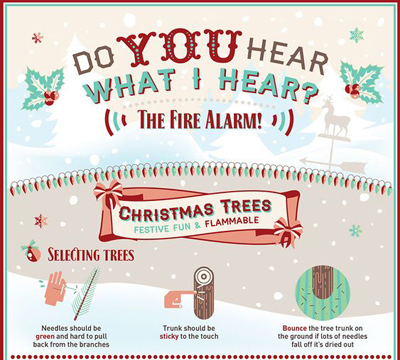The holiday season is a time for family festivities but it is also a time when there is an increased risk of home fires. According to the Garland Fire Department, many holiday activities are some of the leading causes of U.S. home fires. Cooking, Christmas trees, candle usage and holiday decorations contribute to the seasonal causes of home fires. Add to that the hectic nature of the holidays, with people trying to accomplish multiple tasks at once, and the chance for home fires increases even more. By taking preventive steps and following simple rules most home fires can be prevented.
Unattended cooking is the leading cause of home fires and injuries so stay in the kitchen while frying, grilling or broiling food. Most cooking fires involve the stovetop so keep anything that can catch fire away from it, and turn off the stove when you leave the kitchen, even if it’s for a short time. If simmering, boiling, baking or roasting food, check it regularly and use a timer to remind you that you’re cooking. GFD also suggests creating a “kid-free zone” of at least three feet around stove and areas where hot food and drinks are prepared or carried.
December is the peak month for home candle fires. The National Fire Protection Association’s statistics show that two of five home decoration fires are started by candles. GFD encourages residents to consider using flameless candles. If you use traditional candles, keep them at least 12” away from anything that can burn and remember to blow them out when you leave the room or go to bed. Use sturdy candle holders that won’t tip over and are placed on uncluttered surfaces. Avoid using candles in the bedroom where one-third of U.S. candle fires begin. Never leave a child alone in a room with a burning candle.
 According to NFPA, U.S. fire departments respond to more than 225 home structure fires caused by Christmas trees each year. One of three of them is caused by electrical problems and one in five resulted from a heat source that’s too close to the tree. Follow these tips for picking, placing and lighting the tree:
According to NFPA, U.S. fire departments respond to more than 225 home structure fires caused by Christmas trees each year. One of three of them is caused by electrical problems and one in five resulted from a heat source that’s too close to the tree. Follow these tips for picking, placing and lighting the tree:
- Be sure artificial trees are labeled, certified or identified by manufacturer as fire-retardant.
- For fresh trees, make sure the green needles don’t fall off when touched; before placing in stand, cut 1-2” from the base of the trunk. Add water to tree stand and water it daily.
- Make sure the tree is not blocking an exit and is at least three feet away from any heat source.
- Use lights that have the label of an independent testing laboratory and know whether they are designed for indoor or outdoor use.
- Replace any string of lights with worn or broken cords or loose bulb connections. Connect no more than three strands of mini-string sets and a maximum of 50 bulbs for screw-in bulbs.
- Never use lit candles to decorate the tree.
- Always turn off Christmas tree lights before leaving the home or going to bed.
- After Christmas, get rid of the tree. Dried-out trees are a fire hazard and should not be left in the home or garage or placed outside the home.
- Bring outdoor lights inside after holidays to prevent hazards and make them last longer.
Don’t let your holiday go from joyful to tragic. Take precautions to avoid potential fire hazards to keep the holiday season healthy and happy. More information: www.nfpa.org/holiday.


